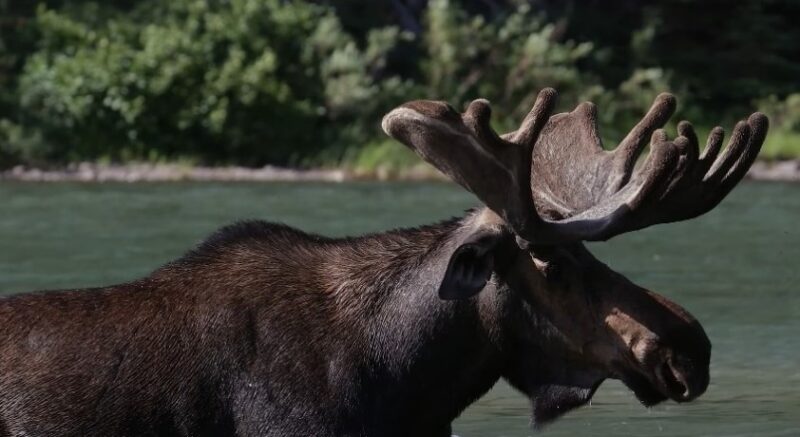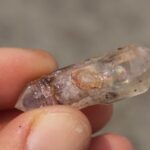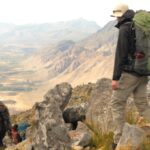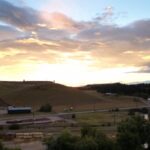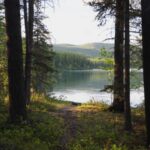If you’re heading to Glacier National Park hoping to see a moose, you’re not alone. There’s something unforgettable about spotting one in the wild – massive, calm, and a little bit surreal as it moves through a misty lakeshore or chews lazily on willows in the morning light.
Glacier National Park, with its glacier-carved valleys, glassy lakes, and dense forests, offers some of the best moose habitat in North America.
But it’s not like they come trotting up to say hi. Spotting one takes patience, timing, and knowing where to look. That’s where this guide comes in.
Key Highlights
- Many Glacier is the top spot to see moose, especially at Fishercap Lake.
- Dawn and dusk are the best times for moose sightings.
- Keep a safe distance – moose can be unpredictable, especially in fall or with calves.
- Use binoculars and stick to quiet trails near water for the best chance.
Glacier Is Prime Moose Country
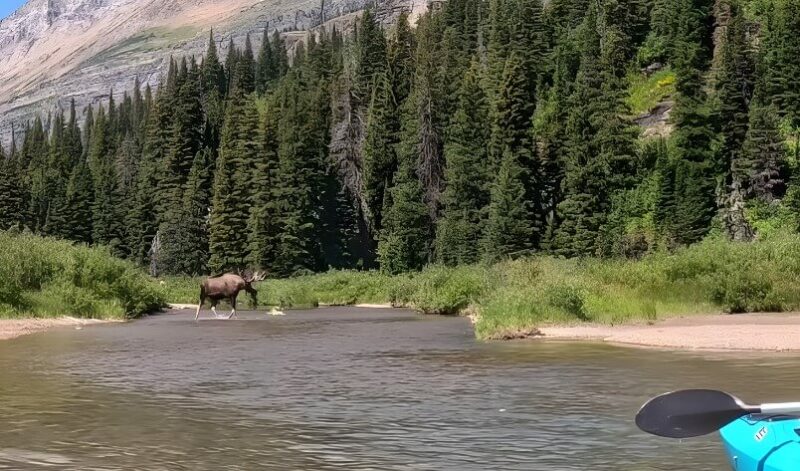
Glacier covers over 1 million acres of protected wilderness, sprawling across Montana’s northern edge and brushing against Canada.
It’s rich with the kind of terrain moose thrive in: wetlands, alpine meadows, slow-moving streams, and forested riverbanks. In particular, moose stick close to water and love areas with willows, aquatic plants, and young trees.
Unlike deer or elk, moose are solitary and less predictable, which adds to the thrill. Their size alone is breathtaking: adult bulls can top 1,200 pounds, with antlers that stretch up to 6 feet across.
Glacier’s quiet corners let them live mostly undisturbed, and give visitors a rare chance to see one in its element. Let’s break down exactly where you’ll have the best odds of seeing moose inside the park.
Top Moose Viewing Areas in Glacier National Park
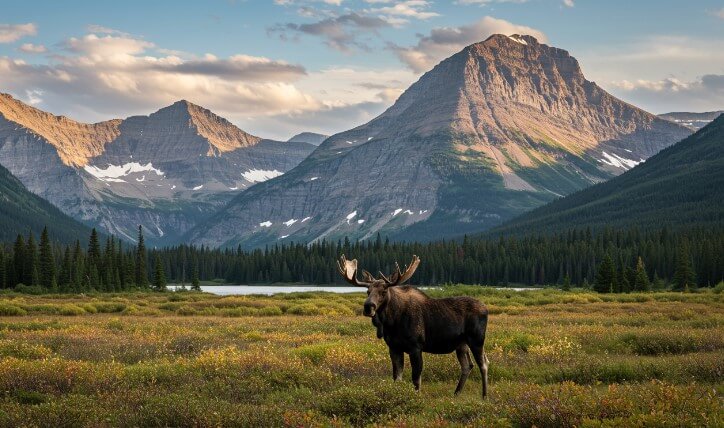
Here are the best spots:
1. Many Glacier Area
If you only have one shot to see a moose, make it Many Glacier. This is hands-down the most reliable area, and for good reason: it’s got everything moose like – still lakes, brushy meadows, and plenty of peace and quiet early in the day.
Fishercap Lake
Arguably the best-known moose hotspot in the park. It’s a short, easy 0.8-mile hike from the Swiftcurrent Pass trailhead, and if you go early in the morning or just before sunset, there’s a solid chance you’ll spot a moose standing knee-deep in the water, chomping aquatic plants.
Bring binoculars or a zoom lens and move quietly. This is where many lucky visitors get their once-in-a-lifetime moose photo.
Swiftcurrent Valley
Keep walking past Fishercap and the trail leads into Swiftcurrent Valley, flanked by Red Rock Lake and Bullhead Lake. Both are well-known moose zones thanks to the willow thickets and calm water that runs through the area.
You’ll also spot birds like loons, Clark’s nutcrackers, and golden eagles if you keep your ears open.
Around Many Glacier Hotel
You don’t even need to hike far. Moose have been seen wandering the meadows and lakeshore near the hotel. It’s worth stepping out with a cup of coffee at dawn and scanning the tree line or the shoreline.
Sometimes, the moose come to you.
| Location | Details | Nearby Hikes |
| Fishercap Lake | Prime moose habitat with shallow water and dense vegetation | Swiftcurrent Pass Trail (0.8 miles) |
| Swiftcurrent Valley | Classic “moose country” with Red Rock & Bullhead Lakes | Redrock Falls, Bullhead Lake |
| Near Many Glacier Hotel | Meadows and lake views attract moose | Grinnell Glacier, Cracker Lake |
2. Two Medicine Area
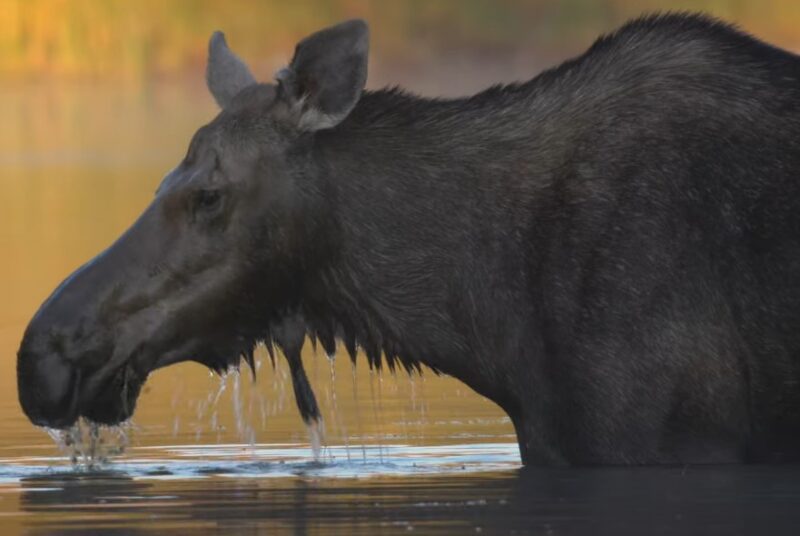
Two Medicine doesn’t get as much love as Many Glacier, which makes it perfect if you’re hoping for a more peaceful experience. It’s got lush meadows and lake edges that moose favor, especially in the early morning.
It’s also a great fallback if Many Glacier is crowded or closed.
Where to Look
Moose can sometimes be seen near Aster Falls or along the trail to No Name Lake. Like always, head out early and move slowly.
| Location | Details | Nearby Hikes |
| Two Medicine | Lakeshores and forest edges; fewer people | Aster Falls, No Name Lake |
3. Kootenai Lakes (via Waterton)
This one takes more effort but can be a rewarding day trip if you’re up for a scenic detour. You’ll need to take the Waterton Lake tour boat from Waterton Lakes National Park in Canada (passport required).
After a relaxing ride, there’s a short hike to Kootenai Lakes, a known hangout for moose and trumpeter swans.
| Location | Details | Access |
| Kootenai Lakes | Quiet lake area known for moose | Waterton boat + short hike |
4. Bowman Lake
View this post on Instagram
Located in the North Fork area of the park, Bowman Lake is more remote, but that’s part of its charm.
Moose sightings are less frequent here, but if you’re camping or heading out at dawn, you might catch one feeding along the water.
| Location | Details | Nearby Hikes |
| Bowman Lake | Quiet, early morning moose activity | Bowman Lake Trail |
5. Apgar Area / Lake McDonald
You’re less likely to see moose on the west side of the park, but they’ve been spotted near Lake McDonald and Apgar, especially during spring and fall.
If you’re already in the area, keep your eyes open, especially in quiet stretches along the lake.
| Location | Details | Nearby Hikes |
| Apgar Area | Occasional sightings near Lake McDonald | Lake McDonald Trails |
How to Increase Your Chances of Seeing Moose
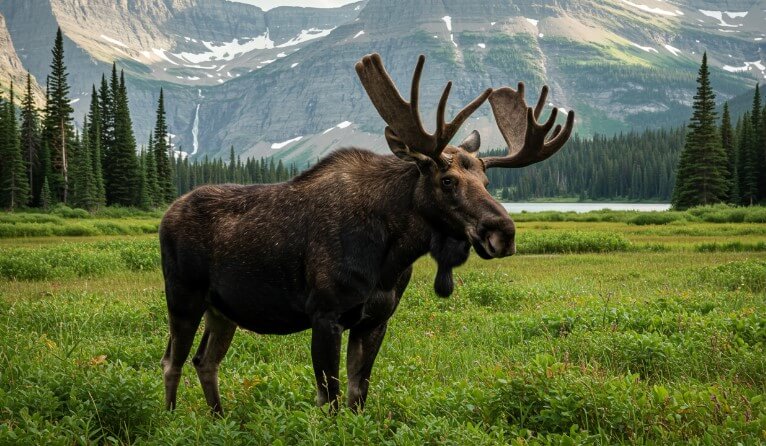
Timing and behavior matter just as much as location. Moose aren’t particularly shy, but they don’t linger out in the open for long.
Here’s how to tilt the odds in your favor:
Best Times to Spot Moose
- Dawn and Dusk: Moose are crepuscular, meaning they’re most active during the low-light hours of sunrise and sunset.
- Spring (May-June): Cow moose give birth to calves, and they’re often seen near lakeshores.
- Summer (July-August): Moose spend a lot of time wading in lakes to cool off and feed.
- Fall (September-October): It’s mating season, so bulls are on the move and sometimes more visible, but also more aggressive.
- Winter (November-March): Less common, but they shift to lower elevations where snow isn’t as deep. Bowman Lake is worth trying.
Pro Tips
- Move quietly. No loud talking, no music. Moose spook easily.
- Binoculars and a long lens are your best friends. You want to observe without getting too close.
- Stick to the trails. Most moose sightings happen right off established paths.
- Look for tracks or droppings. Large, heart-shaped prints and pellet piles are telltale signs you’re close.
- Talk to rangers. Visitor centers like Apgar are great for recent sighting reports.
What Moose Are Like in the Wild
They don’t look real at first. Moose are gangly and huge with a kind of sleepy majesty. Bulls sport wide, palm-like antlers (shed every winter and regrown in spring), while cows are antler-free.
They have long legs and a distinctive flap of skin under the throat called a dewlap. They’re solitary by nature, except when mating or raising calves.
Moose are strong swimmers and can dive over 15 feet underwater to snack on aquatic plants. On land, they browse willows, tree bark, and shrubs.
What You Should Know About Moose Safety
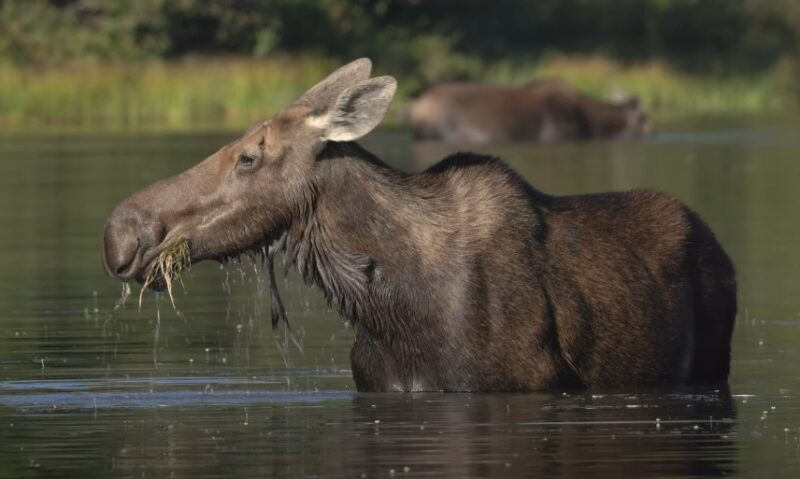
Yes, moose look chill. No, they are not harmless. Give them space. The National Park Service recommends staying at least 25 yards (23 meters) away.
That’s about two school buses end to end. Bulls during rut and cows with calves are especially touchy.
Signs a Moose Is Annoyed
- Ears pinned back
- Head lowered
- Licking lips
- Stomping
If you see that, back away slowly. If one charges, run and get behind a tree or large rock. If you’re knocked down, curl into a ball and protect your head.
Never approach calves. A mother moose will go from calm to charging in seconds if she thinks her baby is in danger.
Ethical Wildlife Watching in Glacier
Glacier National Park is a living ecosystem. Respecting the animals and their home matters.
Do Your Part
- Stay on trails and don’t block moose paths.
- Don’t feed wildlife (ever).
- Pack out everything you bring in.
- Report moose sightings to rangers – it helps monitor populations.
- Don’t post exact locations online if it could lead to crowding.
The goal isn’t just to spot a moose, it’s to do it in a way that keeps them safe and stress-free.
Bonus Tips for Moose Photography
- Golden hour (first hour after sunrise, last before sunset) gives you the best light.
- Use a telephoto lens (200mm+ is ideal).
- Keep your camera ready, moose don’t hang around.
- Shoot from downwind so your scent doesn’t carry.
- Look for reflections in calm water; they can add a dramatic effect.
Check Conditions Before You Go
Montana weather can shift fast. Before heading out, check the official Glacier National Park website for:
- Trail closures
- Weather alerts
- Wildlife activity reports
Snow, rain, and fire season can all impact both trail access and moose behavior.
Final Thoughts
Seeing a moose in Glacier National Park is something that sticks with you. It’s about catching a glimpse of something wild and ancient, moving through a landscape that’s stayed mostly untouched.
Your best odds? Hit the Many Glacier region, especially Fishercap Lake and Swiftcurrent Valley, at dawn. Bring your binoculars, stay quiet, and keep your distance. If you’re lucky, you’ll spot one, and maybe even watch it melt into the trees, as calm and graceful as a creature that size has any right to be.
There’s magic in that moment. Plan for it, respect it, and enjoy every second of it.
I’m Noel Massey, your not-so-typical trailblazer who’s been into hiking for years while herding two mini adventurers, a.k.a. my sons. We’ve tackled trails that would make your GPS do a double-take. Join me as I share tales from the great outdoors, and share some handy tips you could use in the future.

